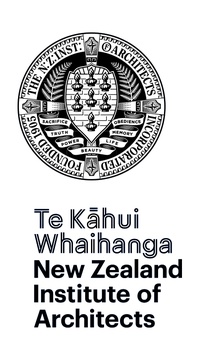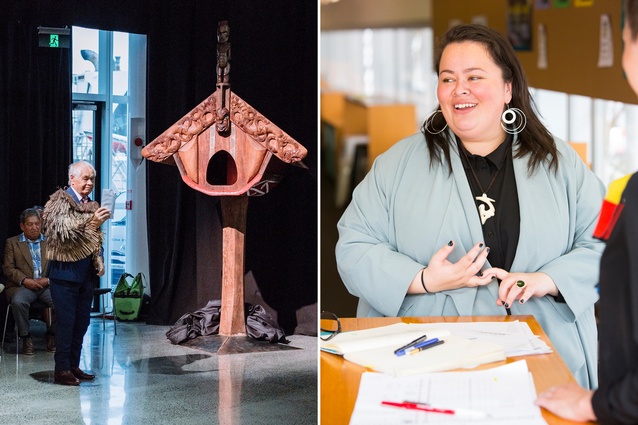The gift of a new cloak
In the New Zealand Institute of Architect’s (NZIA)’s 115th year, and following the 2017 signing of a kawenata (covenant) between the NZIA and Ngā Aho, the Māori designers’ organisation, the Institute has been gifted a Māori name by the eminent teacher, broadcaster and writer Dr Haare Williams, MNZM. The words Te Kāhui Whaihanga will now be incorporated in the Institute’s title.
Dr Williams (Te Aitanga-a-Māhaki, Rongowhakataa, Ngāi Tūhoe) and NZIA Councillor Elisapeta Heta (Ngātiwi, Waikato Tainui) discussed the genesis and meaning of the new te reo title with John Walsh, the NZIA’s communications director, over a cup of tea in Dr Williams’ Papakura home.
John Walsh (JW): Haare and Elisapeta, could you talk about the context for the title Te Kāhui Whaihanga New Zealand Institute of Architects.
Elisapeta Heta (EH): The background is the earlier discussion about the relationship between Ngā Aho and the NZIA. It was Matua Haare who suggested we shift from an MOU – a Memorandum of Understanding – to a kawenata or a covenant, because that suggests something that’s bigger than just a relationship with a legal or formal character, shall we say. Haare, when we talked about the kawenata, we related a lot of that back to your experience of developing a partnership document with Unitec. When you did that, you brought the focus to Te Tiriti o Waitangi. The discussion of a kawenata with the NZIA essentially came down to how the NZIA might acknowledge its relationship to the Treaty, as well as to Māori.
Haare Williams (HW): The kawenata, which is in English and Māori, is a living, dynamic document, and it will contribute to the establishment of mutual respect, and promote the equal standing which we confer on Māori and Pākehā.
JW: As you say, the kawenata is a document in two languages, and now the Institute of Architecture has a title in two languages. What was your approach when considering a Māori name for the NZIA?
EH: There ended up being a big kōrero about the Māori name for the Institute. We started out talking about a name that could be translated into te reo and back into English, more or less, but the discussion became deeper than that.

HW: We decided to bring it down to conceiving and expressing an idea, not just for a building but for building a nation and building people as well. Shaping people – it’s that kind of vision. The name Te Kāhui Whaihanga is not only about architecture, but it’s also about building a nation; building a future and building a people. It’s to do with identity.
JW: Haare, could break down the elements of the phrase?
HW: Te Kāhui is a group of people covered by a cloak that embraces the deeper meanings of knowledge – the taonga of knowledge. The cabinet in Parliament is known as a kāhui, the group that advises the Māori King is known as Kāhui. It’s a group that advises, guides and produces outcomes that are going to benefit its constituents.
Whaihanga is to build. Whai is to pursue, hanga is to shape, so Whaihanga is to build – a house, a nation, a people. Building a house has primary importance in the Māori world. When you walk into a meeting house, you walk into an ancestor; you walk into the womb to be reborn. The meeting house (wharenui) embodies everything that is spiritually, culturally, emotionally and intellectually of great importance in Te Ao Māori.
JW: So ‘Te Kāhui Whaihanga’ has a resonance that extends well beyond a simple translation of the English name of the NZIA?
HW: It is not a translation of ‘New Zealand Institute of Architects’. It’s really an interpretation. It’s a name that advances an idea to another level. This idea of Kāhui Whaihanga is about the ecology of a building, the whakapapa of a building, the way that a wharenui needs to be built by the people from the ground up. I’ve got a poem: “One, two, three lift, and everyone lifts the tāhuhu up to the top.” One lift to lift the ridge pole up to the top. That’s what a wharenui is about. It takes people to put it into place and put its backbone into place. It’s hugely important.
I think the Treaty has become a watershed for New Zealand. Whatever frustrations Māori have had in the past, the Treaty has always been the talisman for that journey ahead. You have te reo starting to come back and have meaning in Aotearoa New Zealand. You have the New Zealand Institute of Architects seeking an appropriate Māori name. That name, Te Kāhui Whaihanga, came from rangitahi, from young people – great leadership was shown by them.
JW: Those three words – ‘Te Kāhui Whaihanga’ – convey a much wider meaning than the title of an organisation.
HW: Māori don’t separate art, architecture, design, music and poetry. They are a seamless part of our culture. There’s no separation of those elements. Astronomy, astrology, hygiene, art, warfare, agriculture and horticulture, religion, you name it – it’s seamless. I call it our literature rather than our culture because our literature is spoken.
I think another overarching thing, apart from the Treaty, is the principle of kaitiakitanga. This is one of the principles in the kawenata between the NZIA and Ngā Aho. Kaitiakitanga is about giving and receiving, and when you receive, you return. The essence of koha is reciprocity. In the Māori world, when you give something, it’s never closed. You expect the return. It might not come in your generation; it might come in your child’s generation. A koha is never closed.
JW: That principle seems to be very relevant to architecture because a building should be something that keeps on giving. Of course, it’s one thing to have a name, and it’s another to use it. What’s next for the name Te Kāhui Whaihanga?
HW: Well, what do you think, John?
JW: I think people will get used to it – some more quickly than others – as it spreads itself through the things the Institute does. It will naturally migrate across the programmes and publications the NZIA produces. I guess, over a period of time – just as Auckland’s art gallery is Auckland Art Gallery Toi o Tāmaki – people will increasingly refer to the New Zealand Institute of Architects Te Kāhui Whaihanga. It won’t be seen as a hierarchy of titles, just as one thing.
HW: Yes, you’ll grow into it, I feel. There’s an increasing awareness now of Māori terms and Māori concepts. I think the reaction to the Christchurch attacks has expressed the evolution of our identity as New Zealanders. The words aroha and manaakitanga and tatau tatau e have been pushed right to the front. People are just using them naturally now. A decade ago, you wouldn’t think that was going to be possible. When I was a journalist, you had to put brackets behind words like kaumātua. I wasn’t allowed to use the word tangi, you had to use the brackets. You don’t have to anymore.
EH: You’re right, the understanding about words like kaitiakitanga, manaakitanga and aroha is becoming universal. Māori expressions are grounding themselves now. They’re less used by a small fraction of society and they’re more understood holistically. I think that what happened after Christchurch was a perfect example of the Treaty in action because Māori, as befits those who are meant to manaaki (support) the people of Aotearoa, were there at every single vigil up and down the country. There was a constant presence of mana whenua, standing alongside Muslim communities at the forefront in every single vigil. For me, that was the perfect example of manaakitanga in action.
Maybe one thing that I could think of in terms of the practicalities of the Institute is that at the moment, we have the values of the kawenata sitting there but might not reference them enough in our work yet. The adoption of the Institute’s Māori title will help there. I believe terms that are in the kawenata here, concepts like rangatiratanga or Mahi Kotahitanga, will become more normal for us to talk about and use and understand, both from a Pākehā perspective and from a Māori perspective.
If you were to take what the kawenata proposes seriously, in your role as an architect, you would think about your role as kaitiaki, as a guardian of the places we’re making, and there would probably be an automatically shift, regardless of budget and client. A shift to little things could turn into big things quite easily. Simple things, like understanding the relationship to site, historic relationships, important tohu (ritual) around an area and the people you might need to have a conversation with, will actually shift, and in turn will shift the architecture. It doesn’t mean that a building needs to have kowhaiwhai (decoration) on it, but it might mean it settles into the land a little better. I don’t think it means that every architect needs to go around talking about how they’ve considered intrinsic Māori propositions. It’s just that they’ve maybe made a slightly different shift in their own thinking that might allow an openness to different conversations.
I find that in the practice of architecture, we still are having to do a lot of proving to our clients the value of involving Māori in projects, of trying to prove the intrinsic value that will be given to at building as a result of engaging with Māori. It just comes back to a establishing a relationship with a place that Māori have a long history with. This will support what you can already do as an architect. I understand how tough the building industry is, but I think it’s a mindset change that has to happen.
HW: It’s happening slowly. Ten years ago, I would never dream of engaging in this kind of dialogue.
EH: The New Zealand Institute of Architects as a name states a fact, where Te Kāhui Whaihanga as a name states an aspiration. I think it’s so important to be clear about what you’re doing, but to be aspirational or inspirational at the same time. I love the balance of these two names things. The NZIA now has an ability to be clear about who it is, as well as potentially visionary.
JW: That’s a very good point. As you say, Elisapeta, the bald name of an institute is just a fact. It doesn’t declare anything about what we hope to do or what we think is important.
HW: I think the values in the kawenta will become integrated with the Institute’s name now. Values like authority and responsibility, knowledge and tikanga (custom) – the protection of not just Māori knowledge but western knowledge as well. Co-operation, working together, and representation – all of these values are expressed in the kawenata, and in the name Te Kāhui Whaihanga New Zealand Institute of Architects.
JW: Thank you very much for explanation Haare and Elisapeta, and for the gift of the NZIA’s new te reo Māori name.
HW: Ka pai, and have another cup of bi-cultural tea, John.
This article first appeared in Tāpoto, a thrice-yearly publication by the New Zealand Institute of Architects in association with Architecture New Zealand magazine.










